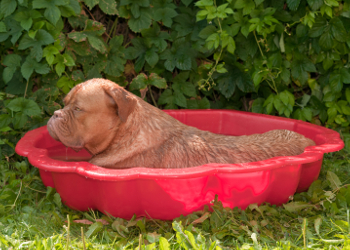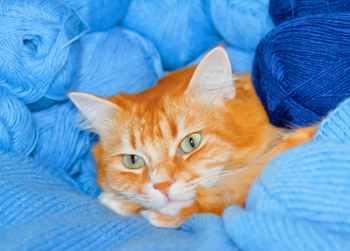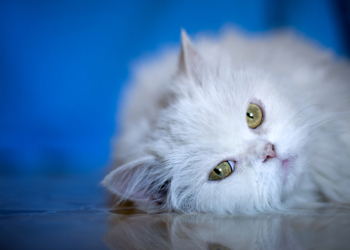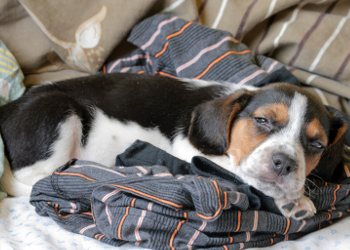Common Diseases & Conditions in Pets C-E

Cutaneous lymphoma is an extension of lymphoma. It is a neoplasia caused by mutational changes to the T or B cell lymphocytes. Lymphocytes are involved in the humoral immune response. The cause of lymphoma in the dog is unknown but any thing such as toxins, immune-mediated conditions might lead to mutations of the lymphocyte.
Lymphocytes are most commonly seen in the spleen, lymph nodes and other tissues. Hence many of the organs affected by this disease are in those locations. This is what is most commonly seen. In other cases the lymphoma is expressed on the skin surface or oral cavities. The presence of these mutated lymphocytes give rise to symptoms commonly seen in cutaneous lymphomas.
The most commonly seen signs with cutaneous lymphoma are the production of itchy, red, scaly masses on the skin. In time these can turn into hairless, inflamed plaques or nodules. These nodules can coalesce together and form one huge mass. The pressure on the skin cells is so intense that these tissues can than ulcerate and get infected with bacteria or yeast organisms.
A biopsy of the mass should be performed. That will differentiate cutaneous lymphoma from other diseases such as: bacterial, fungal or immune-mediated conditions. Radiographs or other imaging procedures should be done as well as a CBC and Chemistry Profile to assess bodily functions.
Diagnosis is only made by histopathological diagnosis once a biopsy has been performed. To differentiate between T cell or B cell lymphoma, requires the pathologist to employ different staining techniques. This is not easy to pick up all the time. It may be a part of a differential diagnosis that may be further investigated after a negative response to antibiotics is seen.
Surgical or chemotherapy treatment may be undertaken but the lesions can reoccur in other places making effective treatment difficult. Both T cell and B cell lymphomas are very difficult to treat.
The long term prognosis for cutaneous lymphoma is poor. Animals end up suffering and the quality of life is usually poor.




Demodectic Mange is transmitted to dogs via the mite, Demodex canis. It is not contagious to people. Although not as common in cats, the parasitic infestation is caused by Demodex cati.
Demodex parasites are often seen living on normal mammalian hosts. All people have Demodex sp growing on their eyelashes. It is natural and does no harm. One of my technicians once doubted me and plucked one of her eyelash hairs and looked under the microscope. Guess what she saw? What keeps Demodex sp under control is the immune system. That is why it is common in young animals since their immune system is immature. This is called juvenile Demodex. It is commonly seen in Doberman Pinschers. They are notorious for having faulty immune systems. That is why they are so susceptible to Parvo Virus. Demodex canis resides and reproduces in the hair follicle of the animal. Demodex cati does the same in cats but is always associated with some other immune-mediated disease. The parasite destroys the hair follicle hence causing associated clinical signs. Transmission is by direct contact with other dogs or cats parasitized with Demodex sp. The canine and feline versions do not cross species barriers. This means that the dog version will not spread to cats and vice versa.
Clinical signs in dogs and cats usually start around the head, face and neck areas. In young animals, small round areas of hair loss (alopecia) are seen that are initially not pruritic or inflamed. These may clear on their own. Lesions may become generalized and cause the animal to itch when a staphylococcus pyoderma sets in. The pruritis in these cases is intense.
The most important lab test is a skin scraping or hair plucking to identify the parasite under a microscope. Some cases may require a skin biopsy to diagnose the condition.
Diagnosis of Demodex sp is by identifying the organism under a microscope. Initial location and appearance of the hairless areas in the dog or cat give thought to this disease. If the animal is young that is also important to notice. All Demodex mites have a long, cigar like body with 4 pairs of limbs. Very easy to see.
Young animals with a few small areas of Demodex canis may spontaneously clear and not require treatment as their immune system matures. Some are treated with Goodwinol®, a topical preparation.
In generalized cases, a strong miticide is required. Mitaban® (amitraz) has been used for years to treat general demodicosis in dogs. Amitraz was initially used as a fruit spray in orchards! Treating this disease is very time intensive and very stubborn to eradicate. Follow the instructions on the bottle. It is very easy to overdose the animal; particularly cats. For this reason, lime sulfur dips are used on cats. Neurological signs are the most common signs seen with overdose. The dog should be bathed with benzoyl peroxide shampoo prior to dipping. The dip should never be wiped off but allowed to dry on the animal. Dips are usually done every two weeks and continued for at least 1-2 months after a negative skin scraping is received.
Ivermectins have been used to treat Demodex sp although it has not been approved for this purpose. Collies should never be treated with any ivermectin. As the old saying goes when it comes to ivermectins…..”White feet, don’t treat….”.
Many dogs and cats have a secondary skin pyoderma and must be treated with appropriate antibiotics for weeks at a time.
The prognosis for juvenile demodex infections is excellent as they usually clear on their own. Generalized demodex infections can be difficult to eradicate but have a good prognosis if client follow through is complete. Cases of chronic demodex are almost impossible to clear or cure and have a poor prognosis.




Diabetes insipidus is not related to Diabetes mellitus. They are totally different diseases. Diabetes insipidus is not common in dogs but it can occur. The majority of cases have an unknown cause but trauma, pituitary tumors or issues with the hypothalmus have been suggested as possible causes.
There are two different types of Diabestes insipidus. Both involve issues with Anti-diuretic Hormone (ADH). This hormone regulates water absorption from the kidney. In neurological D. insipidus, the hypothalmus does not produce as much ADH as needed or faulty storage in the posterior pituitary gland. (Oxytocin is also stored in the posterior pituitary gland). In the nephrogenic version, ADH is produced but there is a faulty renal short circuit occuring that does not recognize the chemical. This occurs when the majority of renal anatomy is totally unrecognizable. Amyloid is the most common cause of that.
The hallmark signs of Diabetes Insipidus are: increased thirst and urination plus production of an extremely dilute urine; almost close to the specific gravity of water. Many animals may not be able to hold their urine and may urinate in the home or their bedding.
Lab work is needed to differentiate Diabetes insipidus from other causes of excess thirst and urination. These are: Diabetes mellitus, Cushing’s Syndrome plus renal and liver disease. A CBC, Chemistry Profile and urinalysis are performed. A specific gravity of almost 1.000 is suspicious and a water deprivation test is performed. Water is withdrawn for a predetermined period and the specific gravity of the urine is checked. In normal dogs, the specific gravity is higher since water is scarce and the urine is more concentrated. In Diabetes insipidus, the specific gravity is unaltered; almost close to 1.003 or so. More specific tests such as ADH levels may be performed.
A diagnosis of Diabetes insipidus is made based on: history, clinical signs plus all laboratory work performed needed to diagnose Diabetes insipidus but rule out other causes of excess thirst (polydipsia) and excess urination (polyuria).
Diabetes insipidus can be treated successfully but not cured. In all dogs vasopressin tannate (synthetic ADH) can be administered by injection or by intranasal drops.
The prognosis for most cases of Diabetes insipidus depends upon the organ effected. Although it can be treated, the prognosis in the central version depends upon the severity and or stabilization of the hypothalmus. In nephrogenic cases the prognosis is dependent upon the pathology associated with renal disease. Every case is different hence a prognosis will vary from animal to animal.




Diabetes mellitus is caused by an insufficient production of insulin in the beta cells of the endocrine side of the pancreas. The pancreas also is made up of other cells that manufacture enzymes used in the digestive system. In cats, a transient Diabetes mellitus is often caused by the administration of estrogens such as Ovaban® that were once used to treat feline miliary dermatitis.
Many dogs develop Diabetes mellitus after a severe bout with pancreatitis. This is most commonly seen in Miniature Schnauzers. These animals have a history of eating trash which causes the pancreatitis and soon after, clinical signs of Diabetes mellitus.
Diabetes mellitus is very common in dogs and cats. The main function of insulin is to facilitate the transfer of glucose into the cell where it is metabolized for cellular functions. This process is slowed down by excess fat around the cells. Diabetes is grouped into two groups. Diabetes type 1 is the typical insulin dependent type while Diabetes type 2 is non insulin dependent. In humans the latter are often treated with drugs that stimulate insulin production such as the sulfonylureas. These do not work in animals. Obese animals suffer from this but all of them require some form of insulin for control. In cats, type 2 is also the prevalent type of Diabetes mellitus.
The classical signs of Diabetes mellitus are: weight loss, tired and reluctant to exercise, excess appetite plus excess thirst and urination. Dogs will develop diabetic cataracts that are seen early in the disease. The owner may report a cloudiness in the eye itself. Owners may also report that, if the animal has urinated in the home on a tile or wood surface, the urine appears sticky.
A CBC and Chemistry Profile must be done. This will give the level of sugar in the blood. Most diabetics will have a blood sugar reading of 400 and up. Some, as high as 800! A complete urinalysis is done. All diabetics will have sugar spilled into the urine. The kidneys can only handle about 200mg/dl of glucose. Over that, it is “spilled” into the urine. This is picked up by a urine dip stick. It will also detect any ketone bodies. Ketones are the result of fat metabolism. If glucose can not be metabolized for energy than fat will be next. Excessive metabolites of fat metabolims known as ketones will be spilled into the urine. If the levels are ultra high, the animal may be ketoacidotic; a severe form of Diabetes mellitus with acidic byproducts present (ketones).
The diagnosis of Diabetes mellitus is made by the history of clinical signs seen by the owner and by physical findings and lab work performed by the veterinarian. The majority of dogs afflicted with this disease are small dogs. Poodles, Maltese, Miniature Schnauzers, Dachshunds and Pugs are commonly diagnosed. About 10% of dogs diagnosed with Diabetes Mellitus are also Cushingoid. No one has figured out which comes first. Sort of like the chicken and the egg analogy. These animals are often diagnosed when the dose of insulin gets to about 2 units per pound to control the blood sugar.
The goals of therapy are to introduce sufficient insulin into the body so as to bring blood sugar down to about 125 mg/dl. If this is accomplished and stabilized, clinical signs will abate. Dogs and cats are administered insulin twice a day. Treatment of diabetes requires a personal and financial commitment to the animal. If the owner goes on vacation, it is recommended that the animal be boarded at the medical facility where staff can administer the insulin and keep an eye on the animal. Numerous types of insulin may be used. Suspensions such as PZI, NPH and lente are commonly used. Solution insulins such as Glargine and Detemir have been used. In cats, the goal is remission of clinical signs. Up to 50% of them will end up in remission. More expensive versions of insulin will lead to a quicker remission. Vetsulin® is relatively cheap but there is a lesser chance of remission on it.
There can be problems with the insulin, operator error or physiological changes in the patient. Changing insulin injection sites is important. If an owner thinks he or she missed the insulin dose DO NOT REPEAT IT! Retest the urine the following day and administer the insulin dose. Giving an extra shot of insulin to a dog that already actually got the shot, will lead to a crash in the dogs blood sugar. Signs such as staggering, glassy eyes and stupor are most common. Animals can easily be brought out of this by smearing KaroSyrup® (light colored version) into the mouth and oral cavity. This is found in the local supermarket. Erratic absorption, excessive exercise or poor diet will make blood sugar readings more erratic.
Dietary control is important. Food should be available to the dog early in the morning. The remainder of the food is than administered at the peak time of insulin activity; usually about 6-8 hours after injecting the insulin. There are excellent diets on the market used to manage diabetes mellitus. Hill’s Prescription Canine w/d, Hill’s Prescription Feline w/d and Purina® Feline DM are good diets.
If Cushing’s Syndrome is diagnosed after the animal is on insulin, Trilostane is commenced to treat the Cushing’s and the insulin dose is cut by anywhere from 25%-33%. By treating Cushing’s, the secondary cortisol induced hyperglycemia will naturally lower. If you add the same dose of insulin to the mix, the dogs blood sugar will crash.
Day to day insulin dosing is often done by testing the urine. An excellent photo display of this technique is available in the “Learn More” section. Taking a dog out to urinate on a leash in the morning and putting a plate underneath to catch urine is pretty easy. Most diabetic cat owners always gave me that blank stare when I told them to get a sample from their cat. The easiest way to obtain cat urine is by using Kit4Cat®. This is a hydrophobic type of sand. The urine pools on the surface so a Diastix® or KetoDiastix® strip can be dipped into the urine.
Management of the diabetic patient also requires numerous physical exams and actual blood glucose readings performed at the peak of the insulins action. Periodically, the animal will be hospitalized to perform a glucose tolerance test where blood is drawn every hour throughout the day after the morning insulin injection. This data is plotted on a graph and interpreted.
Anything can happen to diabetics at any time and many of these problems will occur after hours or on weekends. It is imperative that owners have a local emergency clinic to go to in their area or the telephone number of their veterinarian that accepts after hours emergency calls.
The prognosis for the maintenance of most diabetic patients is quite good. It entails a lot of work on the part of the owner but it can be rewarding. Client education is the key. Understanding the disease and how it is treated helps all concerned. Recognizing when to seek medical attention is crucial for long term survival of the patient. The prognosis for advanced diabetics suffering from ketoacidosis is guarded at best.




Diarrhea is one of the most common diseases in dogs and cats. It produces the greatest consternation in owners also. They want their pet to get better but do not want that new carpet or sofa damaged. Diarrhea is classified in several ways. The easiest to remember is diarrhea of the small intestine and diarrhea of the large intestine. The former will be runny, watery, and can be dark colored due to blood that is broken down in that area. Diarrhea seen in the large intestine is often soft, mucousy and may contain red flecks of blood surrounding the stool. The causes of diarrhea are many: intestinal parasites, maldigestion, malabsorption, pancreatitis, liver disease, change of diet, giving cow’s milk to an animal, eating spoiled or spicy foods, secondary to heat stroke, immune-mediated as well as the more common bacterial or viral infections.
Regardless of the cause, diarrhea acts the same way. In small intestinal diseases, the cells lining the digestive tract becomes sick and often die. This leads to malabsorption and maldigestion in the small intestine. The effect of this irritates the lining and increases the motion or gut motility. This leads to diarrhea. In the large intestine, irritation to the colonic mucosa leads to less water absorption in the area. The lower bowel is where most water is naturally reabsorbed into the body. This leads to increased motility and diarrhea from the large colon.
The most common signs are the production of a watery or loose stool with or without blood present (melena). Dogs are uncomfortable and may attempt to defecate and or strain to defecate more frequently. In severe cases, dehydration occurs. A few animals will vomit. In cats, this observation can be misleading. Yes, cats do develop diarrhea but many times a client will see a cat straining thinking it is either constipated or has diarrhea. In fact, many of these cats are straining to urinate due to a urethral obstruction. Constant straining in cats should immediately be evaluated by a veterinarian.
All animals with diarrhea should have a complete workup. Young and tiny small animals are at a greater risk of dehydration when compared to a larger adult animal. For this reason, a CBC and Chemistry profile should be done. The hematocrit almost always shows some sort of a dehydration profile. Electrolyte losses can be determined via the Chemistry profile. Radiographs may be taken to look for gas distended intestinal loops as well as potential foreign bodies. A fecal exam is always taken to check for intestinal parasites. Since there are a myriad of causes of diarrhea, other tests may be performed as dictated by history and clinical signs. Most adult pets should be screened for acute pancreatitis. This can be done in house using the Idexx® cPL Snap Test in the dog and the Idexx® fPL Snap Test in the cat.
Diagnosis of diarrhea is made by history of a loose or water diarrhea that may or may not have blood in it. Results of a physical exam and all lab work put together attempts to find the causative agent of the diarrhea. Sometimes the diagnosis is unknown (idiopathic) so all one can do is treat the symptoms and reevaluate the patient at a later date.
The treatment of diarrhea is geared towards finding the cause of the diarrhea, reversing the clinical signs plus providing fluid therapy to the majority of patients. If an animal is suffering from diarrhea caused by Parvo virus, that dog is likely to be hospitalized. Mild diarrhea caused by parasites is treated on an outpatient basis.
The most important therapy is fluid therapy. Animals that are lightly dehydrated can be given subcutaneous fluids while being treated for the primary disease. Severely debilitated and dehydrated animals are hospitalized and fluids are administered intravenously. The goal of fluid therapy is to take care of the fluid deficit than switch to maintenance mode to insure the functioning of crucial organs such as the heart and kidneys. Antibiotics are often given to patients. Regardless of the cause, native bacterial flora is out of whack. The good guys have been killed at the expense of the bad guys. Antibacterials are often needed to bring this ratio back in check. Symptomatic care of diarrhea is done via the use of aminopentamide. This drug is superb for the treatment of hypermotility in dogs and cats. Diarrhea causes a lot of visceral pain. It hurts. Butorphanol is often given to decrease the pain plus encourages the patient to rest. Dietary control is important. Owners can make up their own recipe of chicken and rice at a 1:3 ratio and feed small amounts of it at a time throughout the day. Owners may also purchase the appropriate dog or cat version of Hill’s® Prescription i/d food. Animals do well at home with sports drinks. They like the taste and they replace electrolytes lost in vomiting and diarrhea. Sports drinks can also be frozen in an ice cube tray and put in the animal’s water bowl (without water). This quenches thirst without over consumption of water.
The prognosis for the myriad causes of diarrhea is dependent on the cause but the majority of them have a good prognosis if diagnosed and treated early. The key is prevention in many instances. If your dog loves to go dumpster diving, elevate the trash can so the dog can not reach it. Do not give your dog cows milk. If you change your pets food, do it gradually. Mix it in about a 50:50 ratio and over time increase the amount of food you wish the animal to eat. Since many cases of diarrhea are seen in young animals always make sure the puppy is checked for intestinal parasites and current on vaccines. Some dogs are just prone to diarrhea. As they age, German Shepherds are prone to exocrine pancreatic disease and are usually put on a powdered enzyme supplement like Viokase®.




Diskosponylitis is an inflammation of the intervertebral disks and veterbral body plus adjacent tissues. The most common cause of this disease is a bacterial or fungal disease that reaches the nervous system via the blood. It is can also be reached by a septic process.
Diskospondylitis is most commonly seen in large breeds of dogs. Staphylococcus sp bacteria are often incriminated and once the bacteria arrive in the disk and vertebral space, inflammation and reproduction of organisms commences. Bone is destroyed or added and the spinal cord is eventually compressed leading to clinical signs.
One of the most common signs is acute back pain. This is due to the nearby meningitis caused by the bacterial infection. Fever may be present. As the infection and deformities continue, further neurological signs will progress including impairment of function mainly to the hind limbs. Signs are noticed in the posterior of the dog since most infections are localized in the lumbar or lumbosacral areas. Weakness and or unsteadiness of the gait is noticed and even inability to move the hindlimbs may occur.
Radiographs are taken to show the characteristic lesions. The verebral ends and disks will have a moth eaten appearance that appears due to the bone destruction and irregular bone deposition in the area. Blood and urine cultures will often identify the causing agent.
Diagnosis is made by the presentation of a large breed of dog with acute back pain. The history and physical, when combined with radiographs and cultures, will lead to a definitive diagnosis of diskospondylitis.
Treatment is geared towards long term antibiotic doses that have been selected from culture and sensitivity. Antibiotics have to be taken for at least 8 weeks with follow up radiographs to check the progress of the condition. Pain killers and anti-inflammatories are added to control pain. Severe cases will need further spinal stabilization.
The prognosis is dependent upon the response to long term antibiotic therapy and the actual initial severity of neurological signs. Even when the animal may be improving, diskospondylitis can effect other areas of the vertebrae and adjacent disks.




Canine Distemper is caused by a virus belong to the paramyxovirus family. It is extremely contagious and causes disease in dogs, coyotes, raccoons and wolves. Ferrets are carriers of the disease. Young animals that have not been vaccinated against the virus are at the highest risk of exposure.
Canine Distemper virus replicates itself initially in the lymphatic tissues of the respiratory tract, namely the tonsils. Replication extends to the lymphatic tissues of the digestive tract and central nervous system. As the levels of viremia (presence of virus in the blood) increases, clinical signs start to commence. The virus is transmitted by aerosol droplet from dog to dog. Infected bedding and secretions also transmit the virus to an unprotected dog.
Clinical signs arise from the location of viral replication. Young animals develop a fever of 103.0 F and higher. A respiratory cough is present along with watery, reddened eyes. Vomiting and diarrhea are also present. As the disease progresses the virus attacks the central nervous system resulting in neurological signs of crying out and uncontrollable seizure activity. Death occurs soon after the neurological signs. The disease is also called the “hard pad” diseases as some serotypes of the virus cause a thickening and or enlargement of the dogs foot pads.
A CBC will be done that shows a drop in the white blood cell count (mainly lymphocytes). This is typical of most viruses but will lead to a further weakening in the animal’s still immature immune system. There are antibody tests available but most of them can not differentiate between disease antibodies produced and vaccination antibodies produced.
Diagnosis is made by noting the age and the vaccination status of a young animal presented with respiratory, digestive and or neurological signs. Most young dogs around 8-12 weeks that are presented (or develop) seizure activity, usually have Canine Distemper. Understanding where the animal came from also helps. If it was crowded in with other young animals such as a shelter, transmission may have occured there. Lab tests can be done and the virus isolated but most veterinarians diagnose it based on history and clinical signs.
There is no specific treatment for Canine Distemper. Symptomatic treatment is all that is available. Intravenous fluids, antibiotics, anti-vomiting and anti-diarrheal drugs are administered. Seizure activity can be slowed by the using of pentobarbital or facsimile. Once seizure activity starts, it is extremely difficult to completely stop.
The prognosis for most Canine Distemper patients is poor. Those dogs that do survive are never right again. The seizure activity may relapse and even if it does not many dogs have altered personalities after the seizuring has stopped. Many become afraid of people or strange surroundings.
Prevention is the key. Canine Distemper is one of the hallmark diseases that young animals are vaccinated against, starting at 6-8 weeks of age. Colostrum from vaccinated bitches provide some short term passive immunity, but puppies must go through a complete vaccine program to be totally immunized.




Feline Distemper is also known as Feline Panleuopenia. It is caused by a Parvo Virus. Let’s be clear here. Cat Parvo virus is not transmitted to dogs nor is Dog Parvo transmitted to cats! Right after I graduated from veterinary school in 1981, Canine Parvo virus was out in full force. At that time, there were no vaccines for Canine Parvo virus. What we did at that time, was to vaccinate dogs against Parvo virus by using the Cat Distemper vaccine. That is all we had at the time! It worked though. Cats between the age of 2-6 months are the most commonly affected.
Feline Distemper virus disrupts the replication of blood cells at the level of the bone marrow and digestive tract. This can wipe out all white cell types as well as red cells. The latter can make the animal anemic and even weaker to the clinical signs of the virus. Since the immune system is severely weakened, the animal is susceptible to other bacterial and viral infections. This can debilitate the young animal even further.
Clinical signs shown are those caused by the associated place of viral replication. Vomiting, diarrhea, weight loss, dehydration, weakness, anemia, fever and neurological signs. Other generalized signs include anorexia and lack of desire to eat or drink. Extremely sick kittens, regardless of cause, will just sit scrunched up in a little ball and not move.
Animals can be infected while in utero. A queen that is pregnant can pass the virus to her unborn kittens. Those that survive in the third trimester are born with cellebellar hypoplasia. The cellebellum is responsible for maintaining balance and is located at the base of the brain stem. Virus replicates there and kittens walk in circles, totally unable to go straight. In severe cases, they will simply fall over. Cats are amazing creatures. Some of them that I have treated have learned to hold their heads at a particular tilt to get around. This always happens, as adults, in Feline Vestibular Syndrome.
A CBC will show a total drop in white cells as well as red cells. A chemistry profile can show internal organ development. The virus can be detected by using the Idexx® Parvo Snap Test.
A diagnosis of Feline Distemper is suspect when any unvaccinated kitten is presented with vomiting, fever and diarrhea. The presence of cerebellar hypoplasia is a give away for the disease making diagnosis easy. Combined with laboratory data, a diagnosis is made. The virus can be grown in a lab but most veterinarians base their diagnosis on the above. The Idexx® Canine Parvo Snap test is not manufactured for felines but it is accurate enough. Just keep in mind that it is a canine test kit.
There is no specific treatment for Feline Distemper. All treatment is supportive in nature. Antibiotics are given to prevent secondary bacterial infections. High caloric products like Nutrical® or Hill’s® Prescription a/d are administered. Cats are rehydrated and treated for diarrhea and vomiting. As with many viral infections, the first 24-48 hours are crucial for survival.
The infection has an extremely guarded prognosis for the first day or so. Once cats start to eat and drink on their own, they will rapidly start gaining weight. This gives them more “heft” and indirectly helps build up their immune systems. With continued supportive care at home, animals can survive and have a life long immunity to the disease.
With all viral infections such as Feline Distemper, prevention is the key. All kittens should be vaccinated against Feline Distemper at 6-8 weeks of age and undergo a complete vaccine program. Even though survival confers life long immunity I still have vaccinated those animals for the Feline Distemper virus.
The virus is very easy to kill and will respond to dilute Chorox® disinfecting in close quarters where cats are found; such as groomers, boarding facilities and shelters.




Dystocia is a medical term that means difficulty giving birth to any young. The causes are numerous:
1. The uterus gets tired after straining for a long time. It is a muscle and can not effectively contract to expel the unborn animals. This is called uterine inertia.
2. Animals that are presented breach, perpendicular to the birth canal, can cause dystocia.
3. Hind limb delivery can block the birth canal with the hind limbs getting in the way.
4. Puppies can be too big. This happens when a larger male breeds with a small female or the pregnance goes on way beyond an expected due date.
There are three distinct stages of labor in the dog and cat. Dystocia can occur in any of the three stages:
1. The first stage is characterized by cervical dilatation and rupture of the amniotic fetal sac.
2. The second stage is the actual delivery and or passing of the fetus through the birth canal into the real world.
3. The third stage is the delivery of the afterbirth; known as the placenta. Dogs and cats are multiparous, that is they usually give birth to multiple fetuses. A female may pass one fetus than its afterbirth or pass two fetuses and one afterbirth and so on. There is no logic so owners have to be patient.
About 24 hours prior to the first stage of labor the body temperature in the dog (not cat) will drop to about 97 degrees F. The normal canine temperature is 102.0 F. That always indicates labor will start in about 18-24 hours. The female will appear restless, pace around, lay down in her whelping box and just be totally uncomfortable. Once labor begins, a fetus should arrive anywhere up to an hour or they may be born one after another in short order. Never let contractions go longer than 2-3 hours. If this occurs, placental abruption and separation occur and the fetus may be born stillborn.
Learn more about canine obstetrical care of the dog & cat.
Clinical signs of dystocia are readily observable. A female may undergo uterine contractions and all of a sudden stop those contractions. She may get up and act as if everything is done! This drop off in contractions can happen if nothing happens after the drop in body temperature, if she strains and strains and a fetus is not expelled after more than 3-4 hours of contractions. Giving birth causes a lot of pain. If there is a fetal obstruction somewhere, the animal may cry out in pain or constantly lick the vulvar area. Lastly, if a placenta is delivered prior to any fetus, this means that the placenta has separated from the fetus. Females will also have lots of problems delivering when the delivery date comes and goes THAN starts labor.
Lab work is often performed if a placental separation has occured. Decay of any fetus will start up a bacterial uterine infection (metritis) so a CBC may show an elevated neutrophil count. Radiographs and or an ultrasound may be performed to check the position and number of any remaining fetuses in the uterus. Chemistry profiles are necessary to check the general health status of the female plus needed if performing a Cesarean section under a general anesthetic.
Diagnosis of dystocia is made by obtaining a detailed medical history, if available, from the owner. A complete physical exam, including a gloved finger vaginal exam, is performed. Puppies caught at the cervical entrance can easily be palpated by this route. Any of the clinical signs and lab work pointing to dystocia lead a veterinarian to immediately treat the condition.
Treatment of dystocia is accomplished by 2 ways:
1. Employing drugs that stimulate the contraction of the uterus is the first thing done. The drug of choice is oxytocin. This chemical is usually produced in the posterior pituitary gland (along with ADH) and is the natural inducer of uterine contractions. Once an injection is given an animal may or may not start uterine contractions. If they do, and a fetus arrives, another injection may be offered to help deliver the remaining puppies. If all of this fails, surgery is the next step.
2. Cesarean sections are performed on all animals with persistent dystocia and no response to supplemented oxytocin. There is no other way. If a cesarean is not performed, placental separation will result in stillborns plus, if left in the uterine body, will result in metritis. The uterus may also rupture and require an emergency laparotomy. Even if the oxytocin does not result in uterine contractions, it will benefit the maternal mammary “milk letdown”. When a newborn nurses, it stimulated the pituitary gland to release oxytocin. This allows the animal to successfully nurse.
The prognosis for rapidly diagnosed and treated cases of dystocia are usually excellent. During a Cesarean section if the fetuses are all still born, the mother is taken care of surgically and is discharged. Excess milk production and no fetuses to nurse, may lead to mastitis and or a mammary gland “blow out” that requires surgical repair.




The cause of ear mites is the mite, Otodectes cynotis. It is seen most commonly in cats as well as in dogs.
Ear Mites are extremely contagious in cats. They are spread by direct contact from one cat to another. Parasitized queens will pass the parasite on to their progeny so that entire litters of kittens may become infested. The ear mite is transmitted to the skin and has a direct predilection for tissues in the ear. It reproduces there and feeds on cellular ear debris and wax. If left untreated, ear mites can nibble at the tympanic membrane and cause hearing loss. Extreme scratching and head shaking can lead to an auricular hematoma in one or both ears. There is no direct transmission to humans.
Clinical signs produced are associated with the ear mite irritation in the effected ear. The cat or dog will scratch at the ear and shake its head a lot. Inside the external ear canal will be present a dark waxy material. This is ear wax mixed with the fecal matter of the mite. The mite irritates a cat so much that the tissues around the ear may be inflamed and hairless.
The most important lab work is taking a swab from a suspect cat and looking at it under the microscope. The mite is easily visible. They are small and white in appearance in the actual ear canal.
Diagnosis is made by the history, clinical signs and visualizing the ear mite directly in the ear canal or via a microscope slide smeared with otic debris.
There are many preparations that can eradicate ear mites. Pyrethrins and Tresaderm® have been used. One of the best products on the market is Acarrex®. This product contains ivermectin and is resolved with one treatment. Other topical products need to be used for at least 3 weeks. Some cases are difficult to get rid of. A trick of applying a drop or so of a topical to the tip of the cats tail is very effective in addition to the ear treatment.
Some topical flea medications can also eradicate ear mites in dogs or cats. Revolution® & Advantage® Multi are two of those products that work.
Some animals will require oral antibiotics and other therapy geared to controlling a secondary bacterial infection.
The prognosis for rapidly diagnosed and treated cats for ear mites is excellent. Treatment eradicates the parasite just once. A cat or dog can easily get reinfested if in continual contact with a carrier dog or cat. The prognosis for tympanic membrane hearing loss due to ear mites is guarded.



Ectropion is a drooping or eversion of the upper or lower eyelid most commonly seen in Mastiffs, Cocker Spaniels, English Bulldogs and others. The condition is most associated with the lower eyelid and can be caused by trauma to the eye, facial nerve paralysis (one of the 12 cranial nerves) and inflammation of surrounding ocular tissues resulting in a mechanical displacement of the eyelid.
When ectropion occurs it exposes the cornea of the eye and its conjunctiva to drying and infection. Tears are not effectively retained in the conjunctival sac and leak or drain down the side of the face on the affected eye. This “drying” effect can lead to conjunctivitis, corneal ulceration or keratoconjunctivitis (dry eye). This excessive dryness leads to the production of a greenish or yellow mucoid discharge seen in the eye.
Clinical signs revolve around the drying effect of ectropion. Dogs will scratch or paw at the effected eye. In cold, snowy weather animals will rub their faces in snow! It is very painful. The lower eyelid will actually hang down and not make contact with the eye globe. Reddening of the conjunctiva will be seen as well as a dark brown staining pattern below the eye. This staining is secondary to tear proteins running down the animals face causing a dark brown stain. This is very similar to Poodle Epiphora. seen in Toy breeds such as the Maltese or Toy Poodle.
In older animals, a CBC and Chemistry profile may be performed to check if there are any systemic causes of ectropion. Other tests performed are done to check the integrity of the eye and surrounding tissues. A fluorescein stain is performed to check for corneal ulcers. A tonometer test will check intraocular pressures. A Schirmer tear strip will be used to measure tear production levels that may be associated with keratoconjunctivitis (KCS).
Diagnosis of ectropion is made by the clinical history and findings on the physical exam.
Mild cases of ectropion may be treated with just lubricants or tear substitutes that will serve the function of tears. This will lubricate the globe and surrounding ocular tissues. If conjunctivitis is presented opthalmic antibiotics will be prescribed. If KCS is present 1% cyclosporine drops will be prescribed to stimulate tear production.
In more advanced cases, surgical repair is recommended. The eyelid is contoured to a more natural shape. This procedure is highly successful in many animals plus the eye looks more natural with a more closely adhered lower eyelid.
The prognosis for ectropion depends upon the primary cause of the disease be it neurological or trauma. If surgical repair is possible, the majority of animals sustain a very good quality of life.



Ehrlichiosis is caused by a rickettsial organism known as Ehrlichia canis. It also goes by the name of tropical canine pancytopenia.
Ehrlichiosis is seen most commonly in tropical areas of the world. In the United States it is most commonly seen in southwestern states and southeastern states, including Florida. The parasite is transmitted from one dog to another by the common dog tick, Rhipicephalus sanguineous. The disease may also be seen in combination with Babesiosis. Ehrlichia canis is able to hide from the immune system since the parasite lives and reproduces inside the red cell (intraerythrocytic).
In text books, the clinical signs of Ehrlichiosis are lumped into 3 neat little categories but in real life things are not as easily sorted out that way. There can be an acute phase (rapid and lasts several weeks), a subacute form (the animal shows no symptoms but carries the parasite) and chronic phase. This form causes the most clinical problems such as: bleeding disorders due to low platelet counts, an enlarged spleen and peripheral lymph nodes, fever and anorexia. In real life, clinical signs of each phase may be seen in a particular patient. The most dangerous stage is where the animal is an asymptomatic carrier. Ticks can feed on the animal transmitting the parasite to other dogs. It may only be detected on phlebotomy when excessive bleeding occurs. This starts one thinking about platelet disorders such as ITP, Ehrlichiosis and others.
The most important lab test is the CBC and Chemistry Profile. In the majority of cases the platelet numbers will be decreased and often a drop in the number of red cells. Once in a blue moon, the organism may be visible inside the red cell using Giemsa stain. There are PCR tests that can pick up genetic matter plus antibody tests but they are not perfect. A combination of the above are the tests usually performed.
It is actually quite difficult to trip over Ehrlichia canis organisms on routine blood smears. Even trying to find them in lymph nodes and other tissues is difficult. The diagnostic path is the finding of clinical signs, history of tick infestation and the production of antibodies to the parasite. The immune response does not happen overnight. It takes time. In an animal suspected of being infected with Ehrlichiosis, it may take 2-3 weeks for the body to mount an effective humoral response. THAN antibodies can be detected which will confirm a diagnosis of Ehrlichiosis.
Treatment of Ehrlichiosis requires long term use of doxycline to effect removal of the parasite. A minimum of 8-12 weeks is necessary for treatment. Those animals that are anemic or have developed platelet issues require whole blood transfusions.
The prognosis for Ehrlichiosis patients depends upon the severity of the infection. If diagnosed early and treated with doxycline and other supportive measures, the prognosis is good. This will not stop further infections from developing but those that do will be self limiting due to the humoral immune response developed to the first infection. Severe, debilitated animals have a much more guarded prognosis.
Prevention is the key. Without ticks, the disease can not be transmitted between dogs. Tick control is the best prevention. Topical products such as Frontline®Plus are effective as well as collars; particularly Preventic® and the new Seresto®.



Entropion is the complete reverse of Ectropion. In entropion the upper or lower eyelid is inverted towards the eye. The cause of entropion is usually genetic and it is always present by at least 10 months of age.
In bracheocephalic breeds such as the Pug their head structure makes them prone to entropion. In giant or large breeds of dogs there is plenty of loose, dangling skin that can curve inward causing entropion.
When entropion is present, the hairs on the eyelid will curve inward and start to irritate the cornea. This leads to inflammation of the conjunctiva as well as potential damage to the cornea in the form of corneal ulcers. When the animal blinks, the eyelid acts as a windshield wiper blade going up and down over the cornea. That is normal but with hairs following it, irritation will occur.
Clinical signs associated with entropion are: excessive tearing or mucous production, inflammation of the conjunctiva and hyperpigmentation of the cornea due to constant irritation. Entropion hurts and the animal will have a half closed eye and be sensitive to direct light.
A complete eye exam is in order. A common lab test is the flourescein stain. This stain will pick up any corneal ulcer or irritation caused by entropion. In normal dogs, the green flouorecent color does not “stick” to healthy tissue but does so in corneal ulcers. This delineates not only the shape but the depth of the corneal ulcer. At home, if you notice a green dye dripping out of your pets nose on the side of the problematic eye, do not be concerned. That is the way it should be and just means the dogs nasolacrimal duct is draining normally!
Diagnosis is made by the presentation of a young animal under a year of age with eye problems. The veterinarian will visibly see the entropion in the affected eye(s). He or she will also rule out corneal ulcers using the flourescein strip test. Understanding the classical breeds seen with this condition helps.
The most important thing to treat first is the corneal ulcer, if present. A mild ulcer is treated with topical antibiotics to prevent infection plus 1% Atropine drops or ointment to control the associated ocular pain. The entropion may be treated with tear supplements or by surgery. In surgery, a wedge of tissue is removed across the top or bottom eyelid and than stitched together to pull the eyelid outward. Follow up care is crucial to make sure healing is occuring as well as restaining the eye in 2 weeks to make sure the corneal ulcer is healing. When it comes to sight, follow all directions explicitly as well as all followup visits.
The prognosis for rapidly diagnosed and treated entropion cases is excellent. Untreated cases can lead to severe eye irritation and pigmentation. If there are any vascular growths on the corneal surface, an animal can lose sight in the affected eye.



The eosinophilic complex is seen clinically in cats. Eosinophils are one of the five types of white cells in mammalian blood. They are classically elevated in dogs infested or infected with parasites as well as the majority of allergies. This plays a role in the disease as well as the typical response to treatment. The cause of this complex is unknown but there may be a genetic factor not yet discovered. It can be seen in any breed of cat.
Eosinophilic complexes or granulomas are always a response to some type of allergen irritating the cats immune system. This complex is seen usually in 3 distinct forms.
1. A rodent ulcer (as it is called) or small inflamed patch of skin under the chin or on the upper or lower lips of the cats. Years ago, a huge cause of these ulcers was the irritation of red plastic food and water bowls containing a red plastic dye.
2. Small eosinophilic granulomas (scar tissue) that is usually one inch in diameter or less and are round. These may be found anywhere on the skin or inside the mouth.
3. The more severe eosinophilic plaques are almost always seen on the inner groin or abdomen of the cat causing intense misery and irritation to the animal. These plaques are about one inch in diameter and they are raised (thickened) and extend above the skin surface. The outer surface of the plaque is intensely inflamed. Many of these plaques will coalesce together and form one huge massive plaque on the cats abdomen.
The presentation in cats can vary with the individual but almost all will have inflamed reddened areas over their abdomen, face and lips or scar tissue over any part of the body. Because it has an allergic base, all cats will be in a hypergrooming mode. Constant licking which causes further hair loss is seen. Many of these cats will be vomiting or passing hairballs due to the hypergrooming. Constant licking adds moisture to the wounds and can and does lead to a intense skin pyoderma which makes the itching even worse.
The most crucial lab work procedures for eosinophilic complex are: a fecal exam for parasites, CBC, Chemistry Profile plus bacterial or fungal cultures of the skin. Skin biopsies may also be performed to get a histological diagnosis.
Diagnosis is made by noting the characteristic lesions of the eosinophilic complex on the animal. Histopathology will rule out any neoplasms such as carcinomas. The history provided by the owner is also important.
The main drug of choice for the eosinophilic complex are corticosteroids. Most veterinarians will inject an appropriate clinical dose of DepoMedrol®. One injection often works wonders, providing relief from the clinical signs. Antibiotics are used to treat any bacterial pyodermas present. If the cat will tolerate bathes, and that is a big IF, shampooing the animal in a keratolytic shampoo such as benzoyl peroxide with COOL water will provide clinical relief. Flea control should be started plus the possibility of trying a hypoallergenic diet for several months to rule out food allergy.
The prognosis for the majority of these cats is very good. They are very rewarding to treat since medical therapy usually makes the animal feel so much better. However, if the exact cause can not be eliminated in the environment, the cat may suffer a relapse at a future date. I recommend that if owners see the slightest beginning of lesions, to take the animal to a veterinarian for prompt treatment. It will resolve much quicker!



Exocrine Pancreatic Disease (Insufficiency) is seen in a lot of older dogs. Classically, it is most commonly seen in German Shepherds. The pancreas has two components: endocrine and digestive. The former produce crucial hormones for blood glucose regulation- insulin and glucagon. The latter produces numerous digestive enzymes that are secreted into the digestive tract to disgest nutrients. The main cause of this disease is chronic pancreatitis. Since it is seen often in German Shepherds, there is a probable genetic cause also.
When the pancreas decreases the amount of digestive enzymes available such as amylases and lipases, food is not broken down effectively in the small intestine. The resulting bulk present in the intestine leads to chronic diarrhea and weight loss. This weight loss is due to either maldigestion of the food or malabsorption of the food that would normally occur if enzymes were present in sufficient quantities.
The most common signs seen are: chronic diarrhea (often a red clay color) plus weight loss due to maldigestion or malabsorption of nutrients. Since food can not be broken down effectively, the animal will produce more feces than normal and at the same time continue to lose weight even though the appetite may be normal.
As with any internal medical disorder, a CBC and Chemistry Profile may show a monocytosis which is indicative of a chronic disease process going on. An important test to run is the Idexx® TLI test. A lower value will indicate a deficiency in the pancreatic function. This is probably the most reliable test.
Diagnosis is made by the history and clinical signs shown. Weight loss can occur rapidly or over a period of time. The TLI test will also aid in the diagnosis plus a history of the patient suffering from pancreatitis in the past.
Treatment of exocrine pancreatic insufficiency is based on enzyme replacement therapy. Viokase-V® is probably the best known product. It is available in pill or powder form and is administered a bit before meal time so that enzyme activity is ready to roll when the animal has its main meal. This disease is not curable but controlled. This means that the animal will have to take the drug for the remainder of its life. Avoid high fat foods. The diarrhea and weight loss should subside in a couple of weeks. Owners may want to put their pet on a highly digestible product for intestinal tract disease such as Hill’s® Prescription Canine i/d.
The prognosis for patients with this disease are good as long as it is treated before there is extreme weight loss. Excess weight loss also leads to severe metabolic disorders. In those chronically ill animals, the prognosis is much more guarded.

